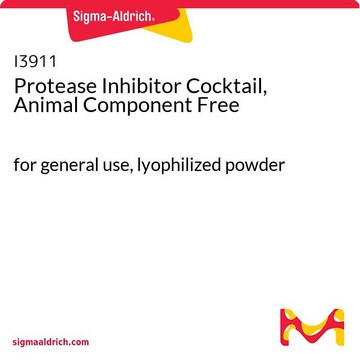535140
Protease Inhibitor Cocktail III
Animal-Free, liquid, for the inhibition of aspartic, cysteine, serine proteases and aminopeptidases
Synonym(s):
Animal free Protease inhibitor
About This Item
Recommended Products
Product Name
Protease Inhibitor Cocktail Set III, Animal-Free, Protease Inhibitor Cocktail Set III, Animal-Free, is a cocktail of six protease inhibitors with broad specificity for the inhibition of aspartic, cysteine & serine proteases & aminopeptidases.
form
liquid
manufacturer/tradename
Calbiochem®
storage condition
OK to freeze
avoid repeated freeze/thaw cycles
shipped in
wet ice
storage temp.
−20°C
Related Categories
General description
Biochem/physiol Actions
Aspartic, cysteine, and serine proteases as well as aminopeptidases
Warning
Physical form
Reconstitution
Legal Information
Signal Word
Warning
Hazard Statements
Precautionary Statements
Hazard Classifications
Eye Irrit. 2 - Skin Irrit. 2
Storage Class Code
10 - Combustible liquids
WGK
WGK 2
Flash Point(F)
188.6 °F
Flash Point(C)
87 °C
Certificates of Analysis (COA)
Search for Certificates of Analysis (COA) by entering the products Lot/Batch Number. Lot and Batch Numbers can be found on a product’s label following the words ‘Lot’ or ‘Batch’.
Already Own This Product?
Find documentation for the products that you have recently purchased in the Document Library.
Customers Also Viewed
Our team of scientists has experience in all areas of research including Life Science, Material Science, Chemical Synthesis, Chromatography, Analytical and many others.
Contact Technical Service















